The Cape York locals hate them, the tourist love them and me, well I chase them on fly.
Queenfish are one of the most underrated sportfish in Weipa for reasons that escape me. These fish grow to well over a metre, have a head on them like a pit bull on steroids, a mouth that would put Luna Park to shame and fight like a Kings Cross ally cat. Oh, and they eat flies.
I have to admit to being a hack when it comes to flyfishing, but because we are talking about queenfish on fly, this actually qualifies me to write this article. Queenies on fly is all about doing the basics and keeping it simple. Just in case there are a real flyfishers reading this, you will be disappointed if expecting any secret techniques or patterns to improve your fishing, instead this is more about being on top of a school of feeding queenies so big that you could save yourself a heap of time and scoop one up in the landing net. Sorry, I have no flyfishing talent at all, however I manage to catch a heap of queenfish.
Locating queenfish is not too difficult. If you are lucky enough to live in a place like Weipa where there are queenfish-a-plenty, you will know where they are because of the constant surface action that they create when feeding early and late in the day. My local boat ramp is home to many as well as the Mission River Bridge, especially at this time of the year when tiny fry are making their way out to the bay. For the past few weeks, there have been football sized schools of queenfish eagerly feasting on what seems an endless parade of baitfish. The bait were no more then 5mm long, making it hard even to match a fly pattern to it but my smallest fly would prove to be a lot closer to the bait then my smallest soft plastic.
There are a few tricks that you need to know about catching queenfish on fly. I have read a few articles over the years and all of them have been loaded with great information however, there are a couple of things that you will learn about me. I like to fish light and I like to keep it simple. I fish with a very basic 8wt outfit with an intermediate sink line running a 10kg fluorocarbon leader. No tapering tippet with a series of knots, just a simple leader of around 3m. Actually, it starts at around 3m and because of the little teeth that the queenfish have, the leader is constantly being shortened to remove any damaged line. Because I am keen to keep fishing I will end up with a metre of leader before I replace it. When queenfish are active, it doesn’t seem to matter. Fluorocarbon leaders are vital as the queenfish are hard on leader material and if you end up with the good sized fish on 8wt tackle, your leader will be working hard for quite a while.
I have a couple of mates who think that I am nuts for throwing my 8wt tackle at queenies and I guess they have a point. I find that as soon as the breeze gets up, a 9 or 10wt outfit is a lot more effective but if you are going to catch a metre long queenfish, why not do it on an 8wt outfit. There is nothing like getting stripped to the backing on just about every hook-up and a lot of the queenfish schools that I fish are little more then rats, ranging from around 40-60cm long, making them ideal for the lighter tackle.
Fly patterns are not that important. Match the fly to the size of the bait that the fish are chasing and you’ll catch plenty. Actually, don’t match the fly and you’ll still catch plenty. It makes a mockery out of traditional fly fishing where bugs are caught so that skilled fly tiers can sit up all night tying flies that mimic the hatch. Small Clousers and Deceivers will catch you plenty of queenfish. An abundance of sliver flash, pink and blue will help but again, the fly isn’t that important. Get the fly pattern in the right ball park and you’ll do OK.
What I think is more important then the fly is the retrieve. Queenfish love a rapid retrieve but ripping line back in as quickly as possible, but it is also vital to set the hook properly. Queenies have a habit of grabbing the fly while swimming towards it and spitting it out before you even feel the hit a lot of the time. My hook-up rate is terrible. I find that I have to retrieve the fly as quickly as possible in order to get some weight on the fish as it hits the fly. Always do this with the rod tip pointing directly at the fish so that long, sloppy rod tip won’t impair the hook-up.
Fighting the fish is a challenge due to how active queenfish are. Keeping weight on the fish while it is jumping and generally playing up is a challenge but a basic rule of thumb is to keep the rod tip low and as much fly line in the water as possible. This will see the fish having to drag the fly line through the water so the more it plays up, the more the fly line will create pressure to help keep the fly firmly in the fish’s mouth.
Big queenfish will take some time to land due to their huge profile helping them to stay deep in the water. Once they stop jumping and go deep on you, it is just a matter of being patient and even those big metre long queenfish will eventually make their way into the net. The trick is not to let them stay under the boat for too long where they can get their second wind. If you are drifting or working from an electric motor, move the boat away from the fish so that it is forced to work against the line pressure instead of just hanging deep and resting. The big ones will still be a challenge but having a fish sitting under the boat for too long is also an invite for sharks and once they turn up, you might as well go home.
Queenfish on fly are great fun if you are just getting into flyfishing. They are keen takers of fly, providing many hook-up opportunities and the fight hard often jumping clear of the water any chance they get. Oh yeah, a fresh queenfish is a delight to eat as well, just don’t freeze one and try to eat it!
Reads: 5907
The tiny baitfish that the queenfish were feasting on, making them ideal targets for fly.
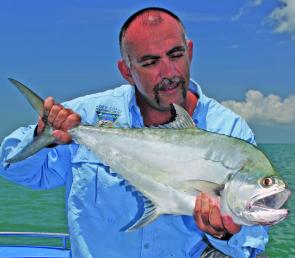
Big queenines like this will have your 8wt tackle working but are great fun.
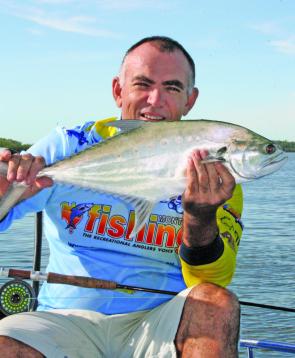
A typical queenfish. Not huge but still able to put up a spirited fight on light gear.
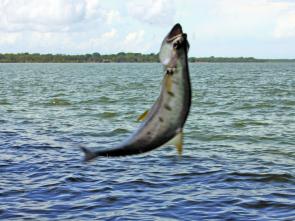
Another queenfish taking to the air.
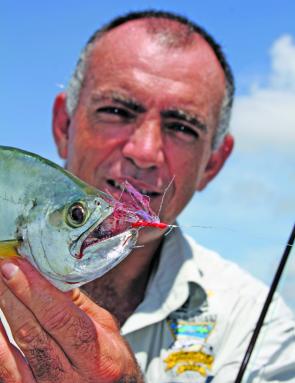
This queenfish is lip hooked but when the fly goes in deep, those teeth give the leader a real workout.
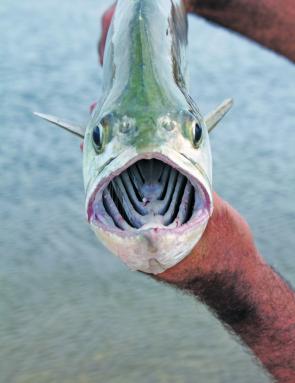
The business end of a queenfish.

Weipa’s Mission River Bridge is home to some monster queenfish which are keen to smash a fast moving fly.




